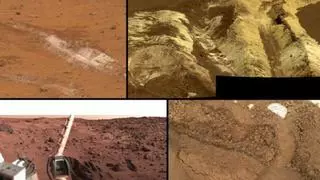
This image shows where NASA's Curiosity rover aimed two different instruments to study a rock known as "Jake Matijevic."Image credit: NASA/JPL-Caltech/MSSS
A rock analysed by NASA’s Mars rover has a surprising and more varied composition than expected, resembling rare rocks from the interiors of Earth, the US space agency said.
“This rock is a close match in chemical composition to an unusual but well-known type of igneous rock found in many volcanic provinces on Earth,” said Curiosity co-investigator Edward Stolper of the California Institute of Technology.
“With only one Martian rock of this type, it is difficult to know whether the same processes were involved, but it is a reasonable place to start thinking about its origin,” Edward Stolper said in a statement.
On Earth, rocks with composition like the ‘Jake’ typically come from processes in the planet’s mantle beneath the crust, from crystallisation of relatively water-rich magma at elevated pressure.
The rover team used two instruments to study the chemical makeup of the football-size rock called “Jake Matijevic“.
The results support some surprising recent measurements and provide an example of why identifying rocks’ composition is such a major emphasis of the mission.
Rock compositions tell stories about unseen environments and planetary processes.
Jake was the first rock analysed by the rover’s arm-mounted Alpha Particle X-Ray Spectrometer (APXS) instrument and about the thirtieth rock examined by the Chemistry and Camera (ChemCam) instrument.
Two penny-size spots on Jake were analysed on September 22 by the rover’s improved and faster version of earlier APXS devices on all previous Mars rovers, which have examined hundreds of rocks. That information has provided scientists a library of comparisons for what Curiosity sees.
“Jake is kind of an odd Martian rock,” said APXS Principal Investigator Ralf Gellert.
“It’s high in elements consistent with the mineral feldspar, and low in magnesium and iron,” he said.
ChemCam found unique compositions at each of 14 target points on the rock, hitting different mineral grains within.
Examination of Jake included the first comparison on Mars between APXS results and from checking the same rock with ChemCam, which shoots laser pulses from the top of the rover’s mast.
The wealth of information from the two instruments checking chemical elements in the same rock is just a preview.
Curiosity also carries analytical laboratories inside the rover to provide other composition information about powder samples from rocks and soil.
During a two-year prime mission, researchers will use Curiosity’s 10 instruments to assess whether the study area ever has offered environmental conditions favourable for microbial life.
More Like This
Published on October 12, 2012











Comments
Comments have to be in English, and in full sentences. They cannot be abusive or personal. Please abide by our community guidelines for posting your comments.
We have migrated to a new commenting platform. If you are already a registered user of TheHindu Businessline and logged in, you may continue to engage with our articles. If you do not have an account please register and login to post comments. Users can access their older comments by logging into their accounts on Vuukle.